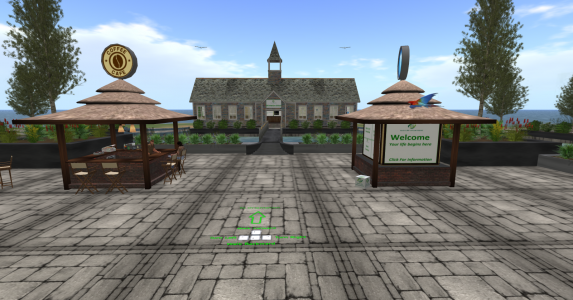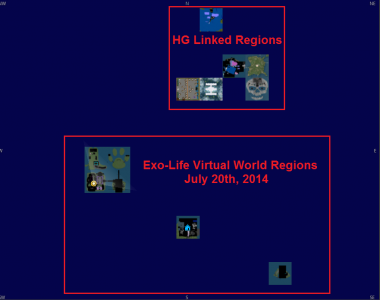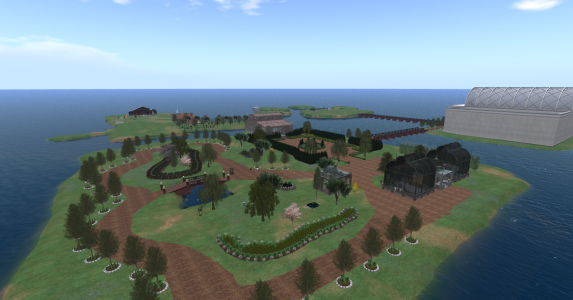
The biggest choice every new grid makes is whether to enable hypergrid or not.
Every single grid up until now has opted for either yes, no, or sometimes.
Newly-launched Exo-Life, however, has picked a different path. It is on the hypergrid, but connects only to eight other grids.
Currently, of the 215Â active OpenSim grids, 142 have hypergrid enabled.
“We decided to do this for a number of reasons,” grid founder Bryan French — also known as Binyamin Wilcox in-world — told Hypergrid Business.  “The main reason was to prevent our users and others from bringing objects from other grids which may not be properly licensed to take to other grids or heaven forbid were stolen and made copyable on another grid.”
And when choosing what grids to connect to, respect for intellectual property rights was a major concern, he added.
“We asked ourselves, ‘Does this grid primarily have original content or licensed content our users may bring to our world?’ and ‘Is this a grid our users would like to explore as a supplement to our own world?'” he said. “Our staff visited every listed grid and some that are not listed in Hypergrid Business, then decided we would link to a total of eight grids.”
Six of those eight grids are Karmalot Grid, FleepGrid, Pathlandia, Japan Open Grid, Selea’s World, and Nemesis 3D. Two additional grids have yet to be determined.

French said that Exo-Life does not use the new “export” permissions to allow creators to control whether their content can leave the grid or not.
“We do not use the new export permission, nor do we foresee using it as it is not a feature our approved viewers use,” he said.
French said that Exo-Life uses several techniques for limiting hypergrid connectivity, some of which are proprietary.
“One technique I can discuss is region linking,” he said.”The result is if one of our residents puts a hypergrid address into the viewer’s map or in the chat bar, that grid will not be found but any linked regions our grid puts on the map the resident may hypergrid to.”
This method works because the grid uses its own custom viewer.
However, the restrictions don’t go into effect until the grid’s grand opening on August 17. Until then, anyone is able to tour the grid via hypergrid, from any other grid, by teleporting to exolife.hypergrid.me:8002.
What is a ‘link region’ anyway?
A “link region” is one of the lesser-known options for facilitating hypergrid travel.
Most commonly, would-be hypergrid travelers type the full hypergrid address into Map->Search, or use a landmark, or walk through a hypergate. A hypergrid address looks like this: hg.osgrid.org:80:wright plaza.
Grid owners can also create “link regions,” however, which are phantom copies of regions on other grids. For example, a grid could put a “link region” to OSgrid’s Wright Plaza on its grid. The link region will show up on a map as if it was a regular, local region and users can search for it and teleport over to it as they would to any other local regions. However, once they arrive, they will actually be on the other grid.
To use an analogy from the Web:
- manually typing a hypergrid address is like typing a URL into your browser’s address bar
- using a landmark is like using a bookmark
- walking through a hypergate is like clicking on a hyperlink
- and having a link region on your grid is like embedding content from another site into your page via an iframe.
How to limit hypergrid access
Other grids can also, if they choose, limit the grids they’re connected to.
“It is something I do for many clients, it’s not hard at all,” said Timothy Rogers, CEO of OpenSim hosting company Zetamex.
To allow only certain connections, or to specifically prevent hypergrid connections, grid owners need to edit their grids’ StandaloneCommon.ini, Robust.HG.ini or Robust.ini files — details here.
For example, a school might allow only other schools to connect to their grid, or a department within a company might link their grid only to other grids owned by the same company.
A world without mesh
At a time when grids are racing to offer new features such as mesh, Bullet physics, and variable-sized regions, Exo-Life is taking a more conservative approach.
“We are a world which aims to be available to users without the resources to update computers every time the next gadget comes out or
who wants a world to run smoothly and simply,” French said. “Thus our grid will never allow mesh, will never have varregions, will not use BulletSim. Such functionality — which may be good for some users or grids — also shuts others out of virtual worlds.”
Despite the lack of varregions, region crossings are still seamless and unnoticeable, French said, a result of choosing high quality hosting. In addition, regions load quickly.
The grid has been in development for over a year, he said, and other co-founders include former Second Life creators, a former Linden Mole, and another former grid owner.
“We have observed many things over the years which grids have implemented at the start and ultimately the grids have failed,” he said. “Our regions are pre-built in house with an emphasis on quality. Residential regions are not simply made up of boring uninspired square island lots that anyone can upload a RAWÂ file of, but rather mini-themed continents with extensive infrastructure. Unlike many grids we do not rely on over-used Linda Kellie regions and prefer to build our own content. What little Linda Kellie designs we chose to use have been extensively redesigned with our own content.”
There is also hidden content on many regions, waiting to be discovered, he added.

The grid will also have a strong events focus, with weekly building classes and game nights, he said.
The grid will have a local currency, but it will be purely fictional, he added, and new residents will automatically received some money to spend in-world to purchase content created by other residents, and to tip DJs and hosts. In addition, residents renting land parcels will also receive stipends.
Exo-Life is operated under the auspice of Kol Ami Havurah, which operates non-commercial educational radio stations and educational Jewish facilities in West Virginia. The grid is intended to be self sufficient and any funds above the operation cost of the grid will be reinvested into the grid to provide additional grid services, said French.
Hosting was provided by Zetamex.
“We have been impressed with their customizable capabilities and placing grids on the nearest data center to users,” French said.
- International singers gather on Alternate Metaverse Grid for first annual International Day - April 15, 2024
- OpenSim hits new land, user highs - April 15, 2024
- Wolf Territories rolls out speech-to-text to help the hearing impaired - April 15, 2024
